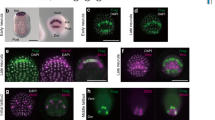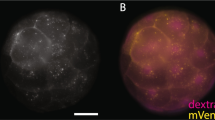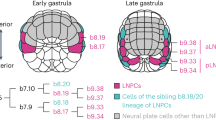Abstract
Cranial neurogenic placodes have been considered vertebrate innovations. However, anterior neural plate border (ANB) cells of ascidian embryos share many properties with vertebrate neurogenic placodes; therefore, it is now believed that the last common ancestor of vertebrates and ascidians had embryonic structures similar to neurogenic placodes of vertebrate embryos. Because BMP signaling is important for specifying the placode region in vertebrate embryos, we examined whether BMP signaling is also involved in gene expression in the ANB region of ascidian embryos. Our data indicated that Admp, a divergent BMP family member, is mainly responsible for BMP signaling in the ANB region, and that two BMP-antagonists, Noggin and Chordin, restrict the domain, in which BMP signaling is activated, to the ANB region, and prevent it from expanding to the neural plate. BMP signaling is required for expression of Foxg and Six1/2 at the late gastrula stage, and also for expression of Zf220, which encodes a zinc finger transcription factor in late neurula embryos. Because Zf220 negatively regulates Foxg, when we downregulated Zf220 by inhibiting BMP signaling, Foxg was upregulated, resulting in one large palp instead of three palps (adhesive organs derived from ANB cells). Functions of BMP signaling in specification of the ANB region give further support to the hypothesis that ascidian ANB cells share an evolutionary origin with vertebrate cranial placodes.





Similar content being viewed by others
Data availability
All data generated or analyzed during this study are included in this published article.
References
Abitua PB, Wagner E, Navarrete IA, Levine M (2012) Identification of a rudimentary neural crest in a non-vertebrate chordate. Nature 492:104–107. https://doi.org/10.1038/nature11589
Abitua PB, Gainous TB, Kaczmarczyk AN, Winchell CJ, Hudson C, Kamata K, Nakagawa M, Tsuda M, Kusakabe TG, Levine M (2015) The pre-vertebrate origins of neurogenic placodes. Nature 524:462–465. https://doi.org/10.1038/nature14657
Ahrens K, Schlosser G (2005) Tissues and signals involved in the induction of placodal Six1 expression in Xenopus laevis. Dev Biol 288:40–59. https://doi.org/10.1016/j.ydbio.2005.07.022
Brugmann SA, Moody SA (2005) Induction and specification of the vertebrate ectodermal placodes: precursors of the cranial sensory organs. Biol Cell / Under Auspices Eur Cell Biol Organ 97:303–319. https://doi.org/10.1042/BC20040515
Brugmann SA, Pandur PD, Kenyon KL, Pignoni F, Moody SA (2004) Six1 promotes a placodal fate within the lateral neurogenic ectoderm by functioning as both a transcriptional activator and repressor. Development 131:5871–5881. https://doi.org/10.1242/dev.01516
Cao C, Lemaire LA, Wang W, Yoon PH, Choi YA, Parsons LR, Matese JC, Wang W, Levine M, Chen K (2019) Comprehensive single-cell transcriptome lineages of a proto-vertebrate. Nature 571:349–354. https://doi.org/10.1038/s41586-019-1385-y
Corbo JC, Levine, M, Zeller, RW (1997) Characterization of a notochord-specific enhancer from the Brachyury promoter region of the ascidian Ciona intestinalis Development 124(3) 589–602. https://doi.org/10.1242/dev.124.3.589
Delsuc F, Brinkmann H, Chourrout D, Philippe H (2006) Tunicates and not cephalochordates are the closest living relatives of vertebrates. Nature 439:965–968. https://doi.org/10.1038/nature04336
Esterberg R, Fritz A (2009) dlx3b/4b are required for the formation of the preplacodal region and otic placode through local modulation of BMP activity. Dev Biol 325:189–199. https://doi.org/10.1016/j.ydbio.2008.10.017
Gans C, Northcutt RG (1983) Neural Crest and the Origin of Vertebrates - a New Head. Science 220:268–273. https://doi.org/10.1126/science.220.4594.268
Glavic A, Honore SM, Feijoo CG, Bastidas F, Allende ML, Mayor R (2004) Role of BMP signaling and the homeoprotein iroquois in the specification of the cranial placodal field. Dev Biol 272:89–103. https://doi.org/10.1016/j.ydbio.2004.04.020
Graham A, Shimeld SM (2013) The origin and evolution of the ectodermal placodes. J Anat 222:32–40. https://doi.org/10.1111/j.1469-7580.2012.01506.x
Hino K, Satou Y, Yagi K, Satoh N (2003) A genomewide survey of developmentally relevant genes in Ciona intestinalis. VI. Genes for Wnt, TGFbeta, Hedgehog and JAK/STAT signaling pathways. Dev Genes Evol 213:264–272. https://doi.org/10.1007/s00427-003-0318-8
Horie R, Hazbun A, Chen K, Cao C, Levine M, Horie T (2018) Shared evolutionary origin of vertebrate neural crest and cranial placodes. Nature 560:228–232. https://doi.org/10.1038/s41586-018-0385-7
Hudson C, Yasuo H (2005) Patterning across the ascidian neural plate by lateral Nodal signalling sources. Development 132:1199–1210. https://doi.org/10.1242/dev.01688
Ikeda T, Satou Y (2017) Differential temporal control of Foxa.a and Zic-r.b specifies brain versus notochord fate in the ascidian embryo. Development 144:38–43. https://doi.org/10.1242/dev.142174
Ikeda T, Matsuoka T, Satou Y (2013) A time delay gene circuit is required for palp formation in the ascidian embryo. Development 140:4703–4708. https://doi.org/10.1242/dev.100339
Imai KS, Hino K, Yagi K, Satoh N, Satou Y (2004) Gene expression profiles of transcription factors and signaling molecules in the ascidian embryo: towards a comprehensive understanding of gene networks. Development 131:4047–4058. https://doi.org/10.1242/dev.01270
Imai KS, Levine M, Satoh N, Satou Y (2006) Regulatory blueprint for a chordate embryo. Science 312:1183–1187. https://doi.org/10.1126/science.1123404
Imai KS, Daido Y, Kusakabe TG, Satou Y (2012) Cis-acting transcriptional repression establishes a sharp boundary in chordate embryos. Science 337:964–967. https://doi.org/10.1126/science.1222488
Kwon HJ, Bhat N, Sweet EM, Cornell RA, Riley BB (2010) Identification of Early Requirements for Preplacodal Ectoderm and Sensory Organ Development. PLoS genetics 6:e1001133. https://doi.org/10.1371/journal.pgen.1001133
Litsiou A, Hanson S, Streit A (2005) A balance of FGF, BMP and WNT signalling positions the future placode territory in the head. Development 132:4051–4062. https://doi.org/10.1242/dev.01964
Liu B, Satou Y (2019) Foxg specifies sensory neurons in the anterior neural plate border of the ascidian embryo. Nat Commun 10:4911. https://doi.org/10.1038/s41467-019-12839-6
Liu B, Satou Y (2020) The genetic program to specify ectodermal cells in ascidian embryos. Dev Growth Differ 62:301–310. https://doi.org/10.1111/dgd.12660
Manni L, Lane NJ, Joly JS, Gasparini F, Tiozzo S, Caicci F, Zaniolo G, Burighel P (2004) Neurogenic and non-neurogenic placodes in ascidians. J Exp Zool. Part b, Mol Dev Evol 302:483–504. https://doi.org/10.1002/jez.b.21013
Manni L, Agnoletto A, Zaniolo G, Burighel P (2005) Stomodeal and neurohypophysial placodes in Ciona intestinalis: insights into the origin of the pituitary gland. J Exp Zool. Part b, Mol Dev Evol 304:324–339. https://doi.org/10.1002/jez.b.21039
Mazet F, Hutt JA, Milloz J, Millard J, Graham A, Shimeld SM (2005) Molecular evidence from Ciona intestinalis for the evolutionary origin of vertebrate sensory placodes. Dev Biol 282:494–508. https://doi.org/10.1016/j.ydbio.2005.02.021
Oda-Ishii I, Kubo A, Kari W, Suzuki N, Rothbacher U, Satou Y (2016) A maternal system initiating the zygotic developmental program through combinatorial repression in the ascidian embryo. PLoS genetics 12:e1006045. https://doi.org/10.1371/journal.pgen.1006045
Ohta N, Satou Y (2013) Multiple signaling pathways coordinate to induce a threshold response in a chordate embryo. PLoS genetics 9:e1003818. https://doi.org/10.1371/journal.pgen.1003818
Pasini A, Amiel A, Rothbacher U, Roure A, Lemaire P, Darras S (2006) Formation of the ascidian epidermal sensory neurons: insights into the origin of the chordate peripheral nervous system. PLoS Biol 4:e225. https://doi.org/10.1371/journal.pbio.0040225
Putnam NH, Butts T, Ferrier DE, Furlong RF, Hellsten U, Kawashima T, Robinson-Rechavi M, Shoguchi E, Terry A, Yu JK, Benito-Gutierrez EL, Dubchak I, Garcia-Fernandez J, Gibson-Brown JJ, Grigoriev IV, Horton AC, de Jong PJ, Jurka J, Kapitonov VV, Kohara Y, Kuroki Y, Lindquist E, Lucas S, Osoegawa K, Pennacchio LA, Salamov AA, Satou Y, Sauka-Spengler T, Schmutz J, Shin IT, Toyoda A, Bronner-Fraser M, Fujiyama A, Holland LZ, Holland PW, Satoh N, Rokhsar DS (2008) The amphioxus genome and the evolution of the chordate karyotype. Nature 453:1064–1071. https://doi.org/10.1038/nature06967
Satou Y, Kawashima T, Shoguchi E, Nakayama A, Satoh N (2005) An integrated database of the ascidian, Ciona intestinalis: Towards functional genomics. Zool Sci 22:837–843. https://doi.org/10.2108/zsj.22.837
Satou Y, Nakamura R, Yu D, Yoshida R, Hamada M, Fujie M, Hisata K, Takeda H, Satoh N (2019) A nearly complete genome of Ciona intestinalis type A (C. robusta) reveals the contribution of inversion to chromosomal evolution in the genus Ciona. Genome Biol Evol 11:3144–3157. https://doi.org/10.1093/gbe/evz228
Satou Y, Tokuoka M, Oda-Ishii I, Tokuhiro S, Ishida T, Liu B, Iwamura Y (2022) A Manually Curated Gene Model Set for an Ascidian, Ciona robusta (Ciona intestinalis Type A). Zool Sci 39:253–260. https://doi.org/10.2108/zs210102
Schlosser G (2014) Early embryonic specification of vertebrate cranial placodes. Wires Dev Biol 3:349–363. https://doi.org/10.1002/wdev.142
Schneider CA, Rasband WS, Eliceiri KW (2012) NIH Image to ImageJ: 25 years of image analysis. Nat Methods 9:671–675. https://doi.org/10.1038/nmeth.2089
Singh S, Groves AK (2016) The molecular basis of craniofacial placode development. Wiley Interdiscip Rev Dev Biol 5:363–376. https://doi.org/10.1002/wdev.226
Steventon B, Mayor R, Streit A (2014) Neural crest and placode interaction during the development of the cranial sensory system. Dev Biol 389:28–38. https://doi.org/10.1016/j.ydbio.2014.01.021
Stolfi A, Ryan K, Meinertzhagen IA, Christiaen L (2015a) Migratory neuronal progenitors arise from the neural plate borders in tunicates. Nature 527:371–374. https://doi.org/10.1038/nature15758
Stolfi A, Sasakura Y, Chalopin D, Satou Y, Christiaen L, Dantec C, Endo T, Naville M, Nishida H, Swalla BJ, Volff JN, Voskoboynik A, Dauga D, Lemaire P (2015b) Guidelines for the nomenclature of genetic elements in tunicate genomes. Genesis 53:1–14. https://doi.org/10.1002/dvg.22822
Tokuoka M, Maeda K, Kobayashi K, Mochizuki A, Satou Y (2021) The gene regulatory system for specifying germ layers in early embryos of the simple chordate. Sci Adv 7:eabf8210. https://doi.org/10.1126/sciadv.abf8210
Tribulo C, Aybar MJ, Nguyen VH, Mullins MC, Mayor R (2003) Regulation of Msx genes by a Bmp gradient is essential for neural crest specification. Development 130:6441–6452. https://doi.org/10.1242/dev.00878
Wagner E, Levine M (2012) FGF signaling establishes the anterior border of the Ciona neural tube. Development 139:2351–2359. https://doi.org/10.1242/dev.078485
Wagner E, Stolfi A, Choi YG, Levine M (2014) Islet is a key determinant of ascidian palp morphogenesis. Development 141:3084–3092. https://doi.org/10.1242/dev.110684
Waki K, Imai KS, Satou Y (2015) Genetic pathways for differentiation of the peripheral nervous system in ascidians. Nat Commun 6:8719. https://doi.org/10.1038/ncomms9719
Acknowledgements
We thank Reiji Masuda, Shinichi Tokuhiro, Chikako Imaizumi (Kyoto University), Manabu Yoshida (University of Tokyo), and other members working under the National BioResource Project for Ciona (MEXT, Japan) at Kyoto University. We also thank the University of Tokyo for providing experimental animals.
Funding
This research was supported by grants from the Japan Society for the Promotion of Science under the grant numbers 21H02486 and 21H05239 to YS.
Author information
Authors and Affiliations
Contributions
BL and XR performed experiments. BL and YS drafted the original manuscript. BL, XR, and YS reviewed the manuscript draft, revised it, and approved the final version.
Corresponding author
Ethics declarations
Competing interests
The authors declare no competing interests.
Additional information
Communicated by Hiroki Nishida
Publisher's note
Springer Nature remains neutral with regard to jurisdictional claims in published maps and institutional affiliations.
Rights and permissions
Springer Nature or its licensor (e.g. a society or other partner) holds exclusive rights to this article under a publishing agreement with the author(s) or other rightsholder(s); author self-archiving of the accepted manuscript version of this article is solely governed by the terms of such publishing agreement and applicable law.
About this article
Cite this article
Liu, B., Ren, X. & Satou, Y. BMP signaling is required to form the anterior neural plate border in ascidian embryos. Dev Genes Evol 233, 13–23 (2023). https://doi.org/10.1007/s00427-023-00702-0
Received:
Accepted:
Published:
Issue Date:
DOI: https://doi.org/10.1007/s00427-023-00702-0




